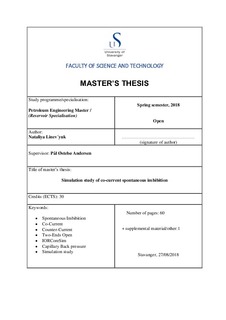Simulation study of co-current spontaneous imbibition
Master thesis
Permanent lenke
http://hdl.handle.net/11250/2581211Utgivelsesdato
2018-08-27Metadata
Vis full innførselSamlinger
Sammendrag
Spontaneous imbibition is the main driving mechanism for obtaining high recovery from the naturally fractured reservoirs with low permeable matrix.
The present thesis presents the results of a simulation study of one-dimensional, co-current spontaneous imbibition in a strongly water-wet sample. Experimental data used for this work was taken from Haugen et al. (2014, 2015). The circumstances of the experiments were characterized by one end face of the core to be open to brine (an inlet) and the other end face to be open to oil (an outlet). Under this Two-Ends-Open (TEO) boundary condition both co- and counter-current flow can take place at the same time, in other words, the inlet can be produced counter-currently and the outlet - co-currently.
The simulation program IORCoreSim was used in this thesis to model the system. The water-oil flow was developed by using Corey relative permeability type and J-function capillary pressure correlation. The experiments were matched by establishing relative permeability and capillary pressure curves. After the match was obtained, the saturation functions were used to perform the sensitivity analysis. It was done by varying several parameters: mobility ratio by holding one of viscosities fixed while changing the other, then both viscosities at fixed mobility ratio, and furthermore capillary back pressure. The last two cases were performed at M=0.01 and M=11.
With increased oil viscosity at fixed water viscosity, the imbibition rate was observed to be lower with decreasing co-current recovery, while counter-current recovery was increased. The breakthrough time was delayed. With increased water viscosity at fixed oil viscosity, the trends for inlet and outlet recovery were similar with increased imbibition time. The breakthrough time was also delayed.
For fixed mobility ratio with varying both viscosities, the trend showed that increased viscosity ratio has no impact on total production and co-current recovery was reduced as M increased whereas counter-current increased.
The capillary back pressure influenced essentially the system at M=11 when compared with M=0.01. Counter-current recovery decreased with increasing capillary back pressure at values beyond the threshold capillary pressure.
Beskrivelse
Master's thesis in Petroleum engineering
